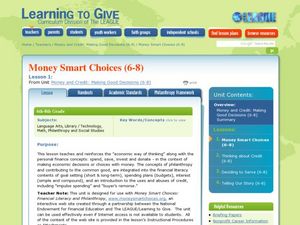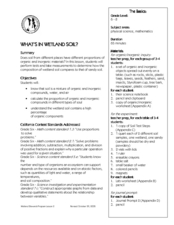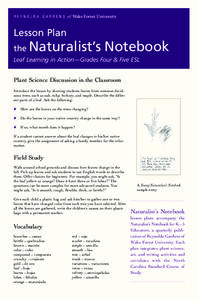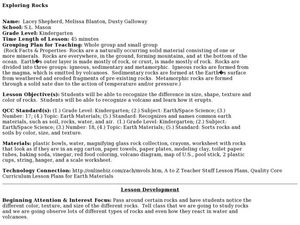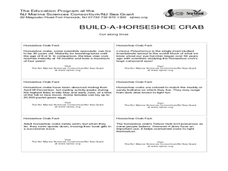Curated OER
Charlotte's Web
Fourth graders focus on fluency by reading the book Charlotte's Web. In this reading strategies lesson plan, 4th graders partner read, do guided reading, and independent reading to increase fluency. Students use Venn Diagrams, discuss...
Curated OER
Take the Lead — Get the Lead Out
Students research about the physiological effects of prolonged lead exposure. In this chemistry lesson plan, students investigate the lead content of different paint, soil and water samples. They analyze data trends and share their...
Curated OER
Size and Shape
Students observe different substances under the microscope. For this space science lesson, students identify the different features of SEM images. They formulate a conclusion about the images of Mars meteorites.
Curated OER
Money and Credit: Making Good Decisions
Students participate in activities that teach them how to manage money. In this managing money lesson plan, students set long and short term goals for economic success by having discussions, identifying benefits of saving, and...
Curated OER
What's in Wetland Soil?
Students examine the organic and inorganic components of soil. For this environmental science lesson, students identify the factors that influence soil formation. They collect soil samples, conduct tests, and analyze the results.
Alabama Learning Exchange
Inner and Outer Planets
Students explore the solar system. In this planets lesson, students learn about the other planets in the solar system. They watch a video clip from National Geographic on the solar system, compare and contrast the planets and create a...
Curated OER
fun with Plants that We Use
Students become familiar with the products made from various plants. In this plants lesson, students experiment with natural dyes from plants. Students complete a list of things made from plants. Students answer questions about plant...
Curated OER
Plant Science Discussion in the Classroom
Students are introduced to the lesson by showing them leaves from common deciduous trees, such as oak, tulip, hickory, and maple. They describe the different parts of a leaf. Students are asked the following questions: How are the...
Curated OER
Grammar and Usage
Seventh graders gain practice in writing sentences according to a specific purpose: declarative, interrogative, imperative and exclamatory. This lesson includes a very thorough worksheet and assessment.
Curated OER
Wetland Food Webs
Students study life science. In this food webs and food chains comparison lesson, students examine the wetlands to discover the relationships that exist between the animals that live there. They participate in group activities and...
Curated OER
Punctuation Review/Tic-tac-toe
Sixth graders play a tic-tac-toe game in pairs. In this language arts lesson, one student uses an X to show the correct sentences, while the other student uses an O to show incorrect sentences. Students use a T-chart to record the...
Pennsylvania Department of Education
Volume of Regular and Irregular Objects
Fifth graders examine patterns and relate to equations to solve math problems. In this patterns lesson, 5th graders diagram, graph, use models and use tables to solve equations for real world problems.
Curated OER
Bhopal - Covalent Bonding
Using the chemicals that leaked in the Bhopal gas tragedy of 1984, chemists examine covalent bonds. Provide for them the chemical reactions and have them draw Lewis diagrams for the molecules involved. That's about all there is to the...
Curated OER
Preposition Practice
Young scholars learn about prepositions. In this grammar lesson, students define prepositions and learn how they work. Young scholars study a list of common prepositions and locate them in sentences.
Curated OER
How to Combine Sentences
Students practice combining sentences. In this writing lesson, students view essays and discuss how it can be revised, using sentence combining. Students practice this skill in their own essays.
Curated OER
Ozone Pollution: Smog Alert
Students examine factors the create smog. In this pollution lesson students complete an activity about ozone.
Curated OER
Exploring Rocks
Students collect and examine rocks. They record information about the rocks they have collected in their notebooks. They compare and contrast different rocks and complete a class chart at the end of the lesson plan.
Curated OER
Simple Machines In Action
Students name and recognize six types of simple machines. They use their research to design an amusement park ride that features different types of simple machines. Students create a brochure about their ride and how it works. Simple...
Curated OER
Is Your Water Clean?
Students compare water quality of different sources. They test water samples for odor, phosphates, pH, bacteria, and dissolved solids. they fill out a data table and answer questions about their findings.
Curated OER
Thanksgiving History
First graders gain knowledge about the first Thanksgiving, how the pilgrims lived and the differences between our Thanksgiving today and the Thanksgivings of the past. They recognize different parts of the word Thanksgiving.
Curated OER
ADULT ESOL LESSON PLAN--Level4-Safety and Security
Students examine a variety of countries specific procedures for identifying and reporting crimes. They review a lengthy list of vocabulary terms to assist them in their research.
Curated OER
What Are The Chances
Students calculate the probability of an event occurring. In this probability lesson, students differentiate between independent, dependent or compound events. They find the range of the data.
Curated OER
7 Ways for Gen Xers to Help Secure Their Retirement
High schoolers explore the concept of budgeting. In this budgeting lesson, students read an article about preparing for retirement. High schoolers create a budget of household expenses during retirement and create a savings plan for that...
Curated OER
Build-A-Horseshoe Crab
Students discover many facts about horseshoe crabs. Students identify the main body parts of horseshoe crab. They explore the habits of the horseshoe crab and their importances to the ecosystem. Adaptations for younger students are...





